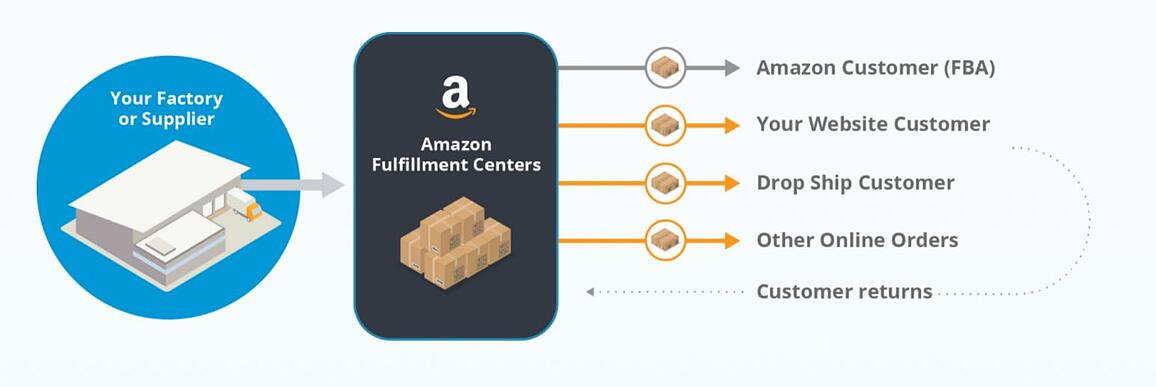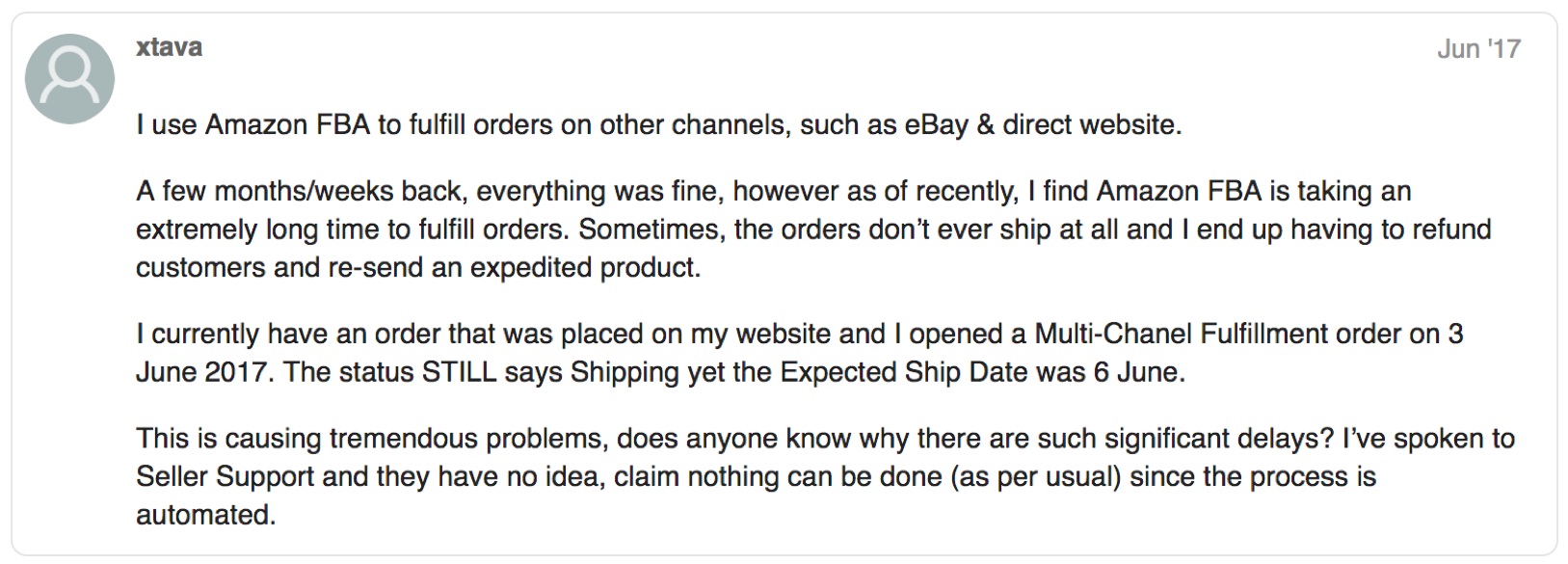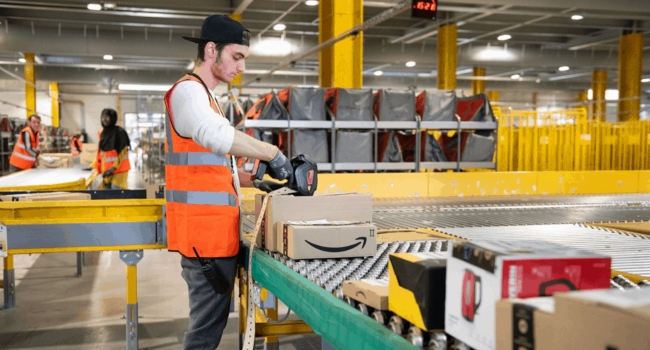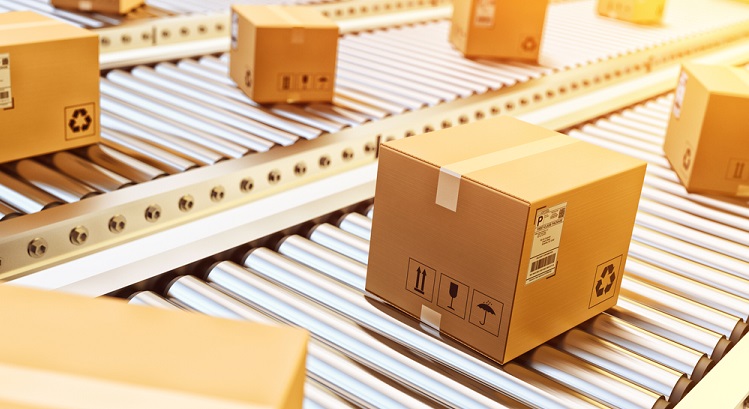What is Amazon Multi-Channel Fulfillment? Should You Use It?
Over the last decade, shopping habits have improved significantly, with worldwide internet store revenues expected to hit the US $2.4 trillion by the end of 2018. In 2017, 44 percent of all eCommerce sales in the United States were made by Amazon alone, and the site draws more than a million new vendors each year.
When you start a store on this platform besides the physical store, you have to handle double the workload, and it is natural to feel frustrated. More orders, more packages, more buyers’ messages…
To make it easier to run an eCommerce enterprise on their website, Amazon has done its part. Amazon Multi-Channel Fulfillment (MCF) Logistics Service helps retailers use the fulfillment and distribution network of Amazon, shipping routes, and even consumer care.
In this article, we will go through the definition of this logistics service by Amazon and help you to find out whether your brand or your company can work well with it or not.
What is Amazon Multi-Channel Fulfillment?
It is an extra service that is more complete than Amazon’s Delivery for vendors on Amazon and can be contacted by those who have a professional vendor account on the website.

You will sell your goods through Amazon, thinking about the logistics for you with the basic Distribution through Amazon operation. Shipments for you are taken care of through the Amazon delivery system, but only those who are via Amazon and in your region.
Here is the positive part: the Multi-Channel Distribution support from Amazon helps you to build on your experience with smoother distribution and streamlined managing. The Amazon Multi-Channel Fulfillment system is a branch of the Amazon Fulfillment (FBA) operation.
This edition covers the management of orders put on your website and even sales in physical stores, in addition to handling orders from Amazon. Moreover, both in your country and on Amazon’s other European platforms, you will be able to send and receive orders.
Read more:
How does Amazon Multi-Channel Fulfillment work?
Similar to how fulfillment through an intermediary or third-party logistics (3PL) business works, Multi-Channel Fulfillment works: you store the goods in their warehouses, and they can oversee fulfillment. The way the system works can be explained and divided into three stages:
Step 1: Store your inventory in fulfillment centers at Amazon
Amazon has a vast nationwide network of e-commerce outlets, but you can only use Multi-Channel Delivery in the United States. You send your goods to Amazon, and they will select the warehouses that hold your products.
Step 2: Amazon collects orders put on your website
Every order that’s put is immediately shipped to an Amazon warehouse by combining the website with Amazon. Thanks to the advance in the logistic system of Amazon, the service of Amazon multi-channel fulfillment will save a lot of money and time.
Step 3: The order is picked, packaged, and delivered by Amazon
Based on the chosen and available shipping options, Amazon will satisfy the order. One factor to remember is that Amazon prioritizes FBA orders over the website’s MCF orders, so possible delays will occur.
What are the differences between Amazon Multi-Channel Fulfillment and Fulfillment By Amazon?
Amazon’s (FBA) delivery has long been a hallmark of the Bezos universe. Traditionally, with this program, Amazon will stock, select, bundle, and ship the items you sell on Amazon.com.
Amazon also provides Amazon Multi-Channel Fulfillment (MCF), an FBA sub-program that reaches beyond its platform to FBA-like sites. In turn, MCF allows you to use Amazon’s distribution facilities for other platforms on which you sell, enabling you to keep the fulfillment and customer service out of your pocket. With the promise of organizational effectiveness, it draws many small-to-mid-sized vendors.
| FBA | MCF | |
|---|---|---|
| Channels | Amazon.com only | Multiple (your e-com store and other marketplaces) |
| Shipping options | Next-day delivery and 2-day shipping (although the COVID-19 pandemic interrupts and delays) | Right the day after, 2-day, and standard (3-5 weekdays) It might take more time than FBA due to the supply process between your store and Amazon. |
| Fees for Account/Setup | - Person Selling Account: Free to sell, higher per sale sales fees. - 39.95 a month, lower purchase fees per sale, Competent Selling Account. |
- Pro Merchant or 39.99 dollars/mo. For the use of FBA / MCF solely for outside networks - Variable per-unit fees by type, weight, etc. |
| Extra fees | - Commission: 15 percent sales referral charge - Fee for Storage - Fee for Shipping and Handling - Sales fees and extra flat payments per sale are higher for individual buyers - Such categories charge extra variable closure rates, such as books and DVDs |
- Based on weight and height, extra MCF fulfillment fees - No commission cost of 15 percent - The same charge for storage as FBA |
| How it works | Step 1. Build lists of items on Amazon Step 2. Prep and ship inventory in keeping with Amazon’s FBA guidelines Step 3. Amazon can pick, prepare and distribute items upon receipt of an order1 |
Step 1. Store your inventory in fulfillment centers at Amazon Step 2. Amazon collects orders put on your website Step 3. The order is picked, packaged, and delivered by Amazon |
| Services | - Inventory - Choose, prepare, and ship - Returns leadership - Support to the client |
- Inventory - Choose, prepare, and ship |
| Fulfillment center venues | Available in 27 states | Available in 27 states |
| Misc. Benefits | - Badge for Prime - Being willing to rapidly ship to all 50 states - Better shipping prices theoretically |
- Being willing to ship on non-Amazon distribution platforms to all 50 states - Better shipping prices theoretically |
Amazon Multi-Channel Fulfillment fees: What you’ll need to know?

The important thing is that in the geographical network you want to reach, you will have to send your merchandise inventory to the fulfillment center that Amazon tells you to.
Besides that, you’ll still have customized fee estimates.
The price that Amazon charges you per order, via the Multi-Channel Delivery service, includes:
- A charge per order, which depends on the package’s size and weight.
- A charge for storage, estimated every month in cubic meters.
- A charge (with various options) for optional items, including handling refunds, marking, and wrapping.
Fees will be added to the above for weight and packaging control, and varying figures based on the product type.
Amazon Multi-Channel Fulfillment costs for Amazon orders
- Lightweight or limited sizes: from €0.80 to €1.90 per shipping (lightweight goods priced below € 10).
- Standard or large sizes: from EUR 1.63 to EUR 30.60 per shipment (weight from less than one kilo to more than 30 kilos).
Amazon Multi-Channel Fulfillment charges for other channel sales
- Local standard shipments: from EUR 3.45 to EUR 21 per shipment.
- Local Expedited Shipments: From EUR 4.73 to EUR 23 per shipment.
- International standard shipments: from EUR 4.70 to EUR 32 per shipment.
- International expedited shipments: from €5.70 to €35.05 per shipment.
All these charges for other channels depending on the size of the package. Only the United Kingdom, Germany, France, Italy, and Spain are covered by expedited international shipments.
Fees for optional Amazon services Fulfillment
- Country returns: from EUR 0.25 to EUR 3, depending on the package’s scale.
- International returns: from 0,65 euros to 10,50 euros, depending on the size of the package.
- Disposal: between €0.25 and €3, depending on the package size.
- Labeling: 0.15 Euros
- Bagging: from €0,45 to €0,90, depending on the package size.
- Bubble wrap: depending on the size of the box, from €0.70 to €1,40.
- Opaque baggage: from EUR 0,90 to EUR 1,80, depending on the shipment size.
- Taping: from €0.20 to €0.40, depending on the kit size.
Note that no VAT or other taxes are used with any of these payments!
And VAT is another fundamental aspect: in any of the countries where you make purchases and shop goods, you would have to register it; there are various requirements and registration thresholds.
While Amazon gives you the option of doing this on your behalf, it’s always best to have a tax team on your own.
Amazon Multi-Channel Fulfillment reviews
What you need to know before using
It is amazing to work with Amazon - a giant in logistics. However, there exist many problems that you need to think twice about before going for Amazon Multi-channel Fulfillment. Since as a separate brand or company, it is about working with intermediaries, and it involves factors in order to balance the business.
MCF Provides All the Power to Amazon
If things turn south, outsourcing such a big part of your e-commerce company as distribution to Amazon may have disastrous implications. If your account is suspended or your product is lost, the store assumes sole control of your inventory, leaving you defenseless.
In other words, your FBA fulfillment network can go down with it if Amazon shuts down your seller account because of poor seller results or other reasons (including those out of your control). Prior to the point of suspension, Amazon will meet pending orders but will no longer accept and ship orders after that. There is still no guarantee that you will be able to get the stock that you have shipped back to Amazon after the fact.
Your Inventory Efficiency Index (IPI) will also be influenced by stranded inventory. If you have a low IPI, Amazon will restrict how much storage space you’re able to use in their FBA warehouses.
Sellers also found that Amazon prioritizes FBA orders over MCF orders, contributing to slow delivery times and canceled orders. It is worth remembering that Amazon Multi-Channel Fulfillment is a sub-service of FBA.
Don’t Let This Happen to You…

One morning, Peter, a recent Top 15 Media Seller on Amazon, woke up to discover that his Amazon account had been permanently deleted. About why? Without any evidence that the DVD in question was his, he was under suspicion of selling a false DVD. He had 55,000 DVDs stored in FBA warehouses — all of which either had to pay 15 cents per unit to Amazon to kill his goods ($8,250 in total) or pay 50 cents per unit to return them ($27,500 in total).
*To make matters worse, a major DVD producer and distributor sued Peter. It turns out that he had crossed off an alternative called “co-mingling” when he signed up for FBA, which allows Amazon to combine its inventory with that of other FBA resellers of that brand (none of these products would have a Merchant ID sticker on them). Sadly, it was too late at this stage … Peter finally lost the case in court. Though once a huge proponent of the FBA program at Amazon, he walked away, defeated, and bankrupt.
Both packages are Amazon-branded, weakening your own name.
By default, any order fulfilled by Amazon will be delivered with Amazon-branded packing slips in a regular Amazon package. Although MCF offers multiple branding options, to ship orders in non-branded boxes, you will eventually have to fork up extra money.
For your clients, this will lead to a jarring experience. Imagine buying from a brand’s Shopify platform and getting an Amazon package in exchange for something. Of course, you’d say, ‘I didn’t buy anything from Amazon,’ and open the package confusedly. Not a terrific first impression. Afterward, as opposed to your website, your buyers can also go back to Amazon.com to repurchase goods or find your brand’s other products.
As a result, Amazon Multi-Channel Fulfillment might not be a good solution to improve and increase the brand cognition or loyal customer base marketing strategy. In case you are running them, you should figure out how to not let it take control over your reputation.
Other markets just won’t consider it.
Walmart openly bans vendors, for the same justification as before, from fulfilling Walmart orders through Amazon.
“Sellers should not use FBA or another device that offers goods bought in the packaging of rivals through Walmart since this indirectly advertises another marketplace and creates uncertainty for consumers,” the company writes.
We have also found other outlets that use FBA MCF, such as eBay, to suppress vendors. Many may not accept Amazon Logistics codes as legitimate tracking numbers, while this last-mile distribution service provides an increasing percentage of FBA MCF orders.
You don’t have power, as an FBA vendor, over the carrier Amazon uses to satisfy orders. If your order is connected to an AMZL code, both you and your customer will lose sight of your package’s location.
You can not decide the location of the physical inventory.
Amazon can select how to disperse the goods when you request an FBA inbound package. This may indicate that in some places you do not have a lot of quantity in store.
“The bigger the number you bring in, the more likely it will all go to the same warehouse,” one seller says.
Amazon can not even use your stock to satisfy orders in the case of “co-mingled” inventory. Peter, the previously mentioned seller, discovered that all his 55,000 units were placed in two FBA warehouses, while orders from other warehouses were fulfilled by Amazon.
Amazon delivered goods from nine separate warehouses as he went to collect his unsold products from Amazon after his account was suspended. In other terms, they gave Peter back the latest sealed products from another vendor.
Maybe it’s more costly than it’s worth.
In addition to delivery, engaging in MCF includes paying for distribution and monthly product handling. Not to note, to list products specifically for MCF, you must be a Pro Merchant (at $40 / month), or you are expected to market your products on Amazon.com simultaneously for them to be available for Amazon Multi-channel Fulfillment.
There are comparatively higher Amazon FBA shipping charges for MCF. If sold on external sites and delivered via MCF, the same item shipped via FBA will cost more per product. Like FBA payments over the holiday season, MCF delivery fees are not cut. But FBA storage fees spike significantly around the board between those months, October to December.
Stale inventory will push up storage prices fast, i.e., Amazon can enforce long-term storage fees after 365 days if you’re having trouble selling the units in your FBA warehouse (Amazon revised these terms in 2019). You’ll be paying $6.90 per cubic foot or a long-term storage fee of $0.15 per container, whichever is better. If you want to get the goods from Amazon, on the other hand, you face delivery and/or removal costs, assuming you can get them back at all.
Coupled with little-or-no oversight about where the product is stored, these separate payments will lead to headaches further down the line.
Pros of Amazon Multi-Channel Fulfillment
Store all of your stock in one spot.

In the world, Amazon has the biggest network of distribution centers. Using the Multi-Channel Delivery facility ensures that your facilities do not have to be operated by yourself. They do the heavy lifting so that you can concentrate on running your e-commerce firm.
Leverage economies of scale with Amazon
Amazon recognizes delivery. With thousands of team members in each distribution center, they have some of the latest technologies and systems to help them operate their warehouses effectively.
Offer fast shipping
Amazon has an almost impossible-to-replicate distribution network. Their supply chain optimizations allow you to provide consumers with quick delivery and reduce shipping costs, even though Amazon Multi-Channel Fulfillment has a more costly distribution plan than that offered by FBA.
While several FBA orders have been postponed for more than a month since Amazon decided to prioritize vital goods owing to the coronavirus pandemic, they indicated that things would quickly return to normal.
Simple pricing
MCF also provides straightforward pricing that is easy to comprehend, in addition to an automated monitoring system. Only determine from their tables the storage costs and fulfillment rates, and you can estimate your expenses. Your organization will be more structured and less chaotic, giving you more time to develop other useful development and promotion plans
Cons of Amazon Multi-Channel Fulfillment
Not all e-com platforms are supported
Amazon is just integrated with Shopify and WooCommerce for now. If you sell your goods on other e-commerce sites such as BigCommerce or famous markets such as Walmart or eBay, Amazon won’t approve your products’ listing or delivery.
Limitations on goods offered
Amazon would not authorize you, via Multi-Channel Delivery, to sell anything. Toys, cards, subscriptions, and those that are all open to Amazon inspection are types of items that have Amazon restrictions, and they may opt not to meet these orders at their discretion.
Amazon uses Amazon branding, also with purchases from the website

All know one drawback to FBA for brands is that orders go to the clients in Amazon Prime branded packaging. But orders made by Amazon Multi-Channel Fulfillment‘s delivery on your website often go into Amazon’s packaging. As clients’ unboxing experience is wrapped in the logo of Amazon, not the branding, this dilutes your branding activities. When they buy anything directly from the website, this may also have a misleading user service, but an Amazon box turns up at their house.
No returns permitted
It’s unavoidable that shoppers would refund items. You can’t count on Amazon to do returns for Multi-Channel Shipping, so you’ll have to pay yourself the expense of doing e-commerce returns. This can get confusing, and if you don’t have your shop, clients have to send returned goods back to your home.
No approved international shipping
Multi-Channel Delivery is confined to the United States and does not permit the right to distribute abroad. You have two choices if your organization has clients around the world: use multinational FBA or find a way to self-fulfill and manage in-house foreign orders.
International FBA demands that you set up separate FBA accounts for the marketplace of each country, administer each listing, and deliver your goods to each country, which is time-consuming, complex, and difficult to handle.
So Amazon Multi-Channel Fulfillment is potential within the States; you may need other methodologies to sell your products for the international marketplace.
Conclusion
For several vendors, Amazon Multi-Channel Fulfillment service is an enticing choice. You will expand the company by using Amazon’s distribution network and not having to think about fulfilling orders in-house. While it has many advantages, there are limits that can set you back.
New Posts






